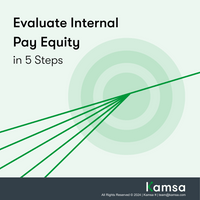
Five Signs It’s Time to Refresh Your Comp Strategy
Best practice suggests that organizations revisit their compensation strategy yearly and refresh it as needed, but what metrics and circumstances should companies watch out for to know it's time to update their pay strategy?
A holistic compensation strategy goes beyond market data, building salary ranges and processing raises for promotions; it's intertwined with company strategy and business needs. Embedding compensation within the company's strategic focus allows the company to make smart pay decisions, supporting sustainable growth and driving company culture.
There are many company milestones that indicate it's time to refresh your compensation strategy. Strategic changes to pay programs and decisions should occur before or during significant organizational events. These conversations should include the management team (i.e., leaders for each major function within the organization) and, depending on the scenario, can also include the talent acquisition team.
Companies should revisit their compensation strategy during or before:
- A new series funding round
- Merger or acquisition
- Compensation review
- Company strategy change
- Culture shifts
Series Funding
It's crucial to revisit pay strategies after a funding round to align finance, recruiters, and hiring managers with the same compensation strategy. Reviewing open jobs and determining what new roles will need to be added to support growth should all go into calculating the projected cost to hire to ensure alignment with a new budget. If you offer equity (i.e.., stock options) to employees, you’ll want to revisit the new hire and refresh grant guidelines to align with the company’s latest estimated per-share value and latest market equity data.
M&A
Mergers and acquisitions can be tricky to navigate through the context of talent considerations. Assessing talent needs and the corresponding compensation strategies requires a complete understanding of company goals and business needs. Also, you’ll want to consider how you want to blend both organizations’ historical compensation practices and philosophies into one. During and after M&A is a good time to refresh job levels across the combined organization and make sure career paths align with any new business direction and goals.
Before a Compensation Review
Companies should revisit their compensation strategies 3 to 6 months before a compensation review, and it's suggested to perform compensation reviews at least annually, and even better if you’re able to run them in a cadence of 2 reviews per year.
Company Strategy Change
Company strategy changes can include large product development or innovation-driving projects, expanding to new regions, and org restructuring. Other strategic focus areas could include sweeping budget constraints (i.e., when the budget is very limited or when profitability/EBITDA goals are top priority).
Essentially, whenever there's a significant change in the makeup of company structure or approaches, HR and people leaders should collaboratively evaluate the career paths to ensure business needs are being met.
Company Culture Shifts
Companies need to know when the culture is impacted by its compensation structure, and it's even more important to act quickly on it when the discrepancies are noticed.
Reasons for a compensation restructure surrounding culture include:
- Recruiting difficulties
- Pay inequities
- High turnover rate
Recruiting Difficulties
Recruiting struggles may be linked to the need for a full compensation strategy refresh. Suppose recruiters notice a trend in not being able to attract the right talent, especially those with unique skill sets or resource-constrained skills. In that case, reevaluating the target percentile for those jobs or job families might be the right strategy.
Recruiters should also gather feedback from their experience in closing (or lack of ability to close) candidates and provide their trends on what they see in the market to equip the People team with potentially targeting a different percentile or shifting in compensation philosophy.
Pay Inequities
Many different things can cause pay inequities. To identify any inequities, a company must determine each employee's compa-ratio. A compa-ratio quantifies how competitive an employee's pay is compared to the market. It's calculated by the employee's base salary divided by the market midpoint for their matched job (a compa-ratio of 100% means they're being paid at the market midpoint).
Keep an eye on compa-ratio trends. For example, when there are consistently very low compa-ratios, examine the internal trends. Are they low only for a particular department, demographic group(s), or job families? Is there a significant difference between the average compa-ratios of new hires vs. employees with one or more years of service?
Once the trends in any extremes are determined, the People team can establish plans like conducting a compensation review focused on market adjustments.
High Turnover Rate
Often, the most common reason employees leave a company is related to compensation. If you notice a high turnover rate, it may be time to reevaluate the market and the company's compensation philosophy. If the target percentiles meet your business needs, other factors may be considered, like hiring more employees in that role to support the team.
The Solution
As a company matures and grows, its approach to compensation will need to evolve to support it - from expanding career structures to reevaluating the market targeting approach. As with all successful initiatives, communication is the key to success when it comes to building a successful compensation program.
Communicating with leaders while job leveling and establishing career paths will set the foundation for future communications company-wide. Incorporating, planning, and rolling out clear communications surrounding compensation helps ensure leaders, recruiters, and employees have the same understanding and insight into the company’s compensation strategy.
About Kamsa
Kamsa helps companies make intelligent pay decisions. Our hybrid approach to compensation facilitates all of the administrative burden surrounding compensation and provides strategic solutions for leadership teams when making compensation decisions. We empower organizations to effectively plan and budget salary and equity reviews by providing reliable, global market data that equip leaders to make holistic + informed compensation decisions.


